- Home
- Deborah Blum
The Ghost Hunters Page 9
The Ghost Hunters Read online
Page 9
He was riven by the belief that he should have known, should have prevented it somehow. The elusive Annie Marshall, with her unforgettable “sea-sapphire” eyes, had been desperately unhappy for years. Her life with husband Walter Marshall, Myers’s cousin, had descended into despair along the spiral of his mental illness. The extended family had tried to support the couple. Myers himself had gone to Switzerland, in 1875, to find some new doctors for Walter, to comfort his wife, and—to their mutual dismay—to fall in love.
Myers filled his diary with poetry about her beauty, her sadness and the way his “soul sprang to meet her ...”
After Walter’s behavior became so violent that he was institutionalized, Myers’s mother offered Annie a home, and Myers wrote her brisk, friendly letters. His instincts told him that the last thing Annie needed, at the moment, was a suitor. Resolved to hide his true feelings, he confided to his diary that he preferred “irredeemable woe to the slightest shadow of wrong.”
But with Walter locked away, Annie fell apart. She seemed to blame herself, Myers’s mother wrote him. The morning after she sent that worried letter, fretting over her houseguest’s sudden silent withdrawal, Mrs. Myers could not find Annie Marshall in the house. She ran outside to look, eventually reaching a nearby lake, and to her horror found Annie’s lacy shawl crumpled by the water’s edge. Alongside the shawl was a bloody pair of scissors.
The body was found floating in the deep middle of the lake. When they pulled Annie out of the water, they realized that she had tried to slash her throat first, but the wound was too shallow to kill. In the despairing dark of early morning, she had then walked, bleeding, into the shallows, and on, until the lake closed over her head.
The news, Myers wrote, “made dim with woe the reeling world.” He was wrenched with feelings of guilt and inadequacy. He began to believe that he must talk with Annie again—for both their sakes.
The following year, Sidgwick insisted that Myers go to Paris to explore the medium scene there. Frankly, he mostly wanted to put his friend back in motion; Myers had remained miserable, uncharacteristically antisocial and lethargic. Certainly, Myers complained about the summer 1877 trip to France. Life seemed discouraging to him after Annie Marshall’s death. And, along with his friends, he was discouraged by their psychical results—or lack of results—thus far. But on his duty trip to France, for the first time, Myers caught the dark scent of the occult in the air.
He hadn’t expected it, and it came without flourish. In one visit to a tidy home where a pleasant middle-aged French woman specialized in table talking, the knocks in the wood had suddenly spelled out a name—“Annie.”
The startled Myers had demanded that the medium tell him what relationship this Annie had to him.
“Cousin,” came the reply.
It was, Myers wrote to Sidgwick, perhaps a case of thought reading, the kind of unexpected insight that William Barrett had detailed in his experiments.
A few days later Myers met with a fat old medium in a filthy Paris bystreet near the buttressed walls of Notre Dame Cathedral. She wore a too-tight dress with its lace-edged skirts flapping around her ankles. She sat on a small wooden stool and leaned against a stone wall, holding a tray of wooden alphabet tiles.
The medium claimed that when sitters touched the right letters on the tray, the spirits rapped in response. As he confessed, Myers had to fight to keep a straight face. He decided just to have some fun with it.
“I despaired of getting a high spirit thro’ this low woman & amused myself by laying traps—i.e. thinking of the right words but pausing & trembling at the wrong letters.”
To his surprise, though, he found the letters that the medium picked out seemed to follow his thoughts rather than his actions. Slowly they stumbled through an attempt at a name: ANNE ELISE MARSEH PAR MARESHELL.
Standing in the grubby alley, Myers thought he felt the oddest little chill down his back, unnerving as it was invigorating.
Even so, even as Myers welcomed that shiver of hope, he was aware it might be time to let Annie go in favor of living companionship. He was surrounded by domesticity. Not only was Sidgwick happily married, but in the spring of 1877, Gurney had also given up bachelorhood.
There were hints that Gurney’s pretty wife, Kate Sibley, had married for money. But the couple seemed happy enough together. Kate’s quick chatter and light laugh made a bright counter to Gurney’s quiet nature and occasional dark moods. She’d been keeping him unusually busy too, redecorating their home in London’s Montpelier Square, coaxing him out to the theater and to dinner parties.
Myers found himself more alone than usual, less satisfied with pursuing an affair with a ghost. And there was one woman he did, find charming, a dark-haired society beauty named Eveleen Tennant. She was looking for an older man to take care of her; she loved his enthusiasm, his intelligence, and his open-minded approach to the world. “With you,” Evie told Myers, “I can be my wild, natural self.” He was delighted by her beauty and passion. In his diary, Myers tended to sketch rabbits by her name. Six months after they met, in 1880, they were married in a formal wedding at Westminster Abbey.
Evie Myers had no reason to doubt herself. A talented portrait photographer, she was known for her images of the well connected and powerful. The National Gallery would eventually acquire much of her portfolio, including a rather dreamy portrait of Nora Sidgwick’s brother, Arthur, during his political rise to prime minister and another of Robert Browning, glaring at the camera with the intensity of a trapped hawk. Yet for all her accomplishments, the artist clung to her new husband as if she were his needy child.
“You can live without me,” she wrote in one overwrought letter, “but I cannot live without you.” She sensed in Myers an emotional distance that troubled her. Did he compare her, she wondered, to women in his life who were more intellectual and independent? “Fred my king and my love,” she continued, “I will try & be worthy of you but do not want me to be like your dear mother or Mrs. Sidgwick. I can’t.”
He reassured her, but he didn’t tell her the truth. Of course he didn’t want her to be like his mother or Nora Sidgwick. He wanted her to be like Annie Marshall. Long after they were married, after their three children were born, Myers would still look at his beautiful wife and want her to be Annie Marshall, apparently forgetting that it was so much easier for the dead to keep their perfection.
IN 1881, after five years of conducting tests and compiling results in his spare time, William Barrett published his second report on the science of thought transference.
His results, summarized in the esteemed journal Nature, detailed test after test, done with a carefully chosen set of people, identified through their willing-game success or other evidence of mind-reading abilities.
Among them were three young girls, daughters of a Presbyterian minister, who seemed startlingly responsive to Barrett’s mental instructions. Barrett assured readers that he took constant measures to prevent cheating in the experiments. For one series, he settled the girls in the family parlor and then closed himself up in their father’s study. Once seated at the heavy oak desk, Barrett began slowly listing household objects on a sheet of paper.
The only instructions he gave the girls were to bring him the object that entered their minds. Only after they’d brought one object to the study—and he’d either accepted it or told the bringer to try again—would another command be put to paper. “Having fastened the doors. I wrote down the following articles, one by one, with the results stated: hairbrush, correctly brought; wine glass, correctly brought; orange, correctly brought; toasting-fork, wrong on first attempt, right on second; apple, correctly brought; smoothing-iron, correctly brought; tumbler, correctly brought; cup, correctly brought; saucer, failure.”
Lucky guesses were certainly possible, but, Barrett thought, not to this degree of consistency. Further, there could be no accusations of secret nudge-and-wink techniques, as with the willing game, “for there was no contact, and in some tria
ls (as in the foregoing) the percipient was out of sight and hearing.” It was possible that the girls had cheated, but it was difficult to see exactly how. Barrett’s requests had sometimes been impromptu, and when they weren’t, he hadn’t discussed them.
What he saw was not a solution to the mystery he’d raised earlier but rather more mystery, “a large residuum of facts wholly unaccounted for.” There was a notable difference in this paper’s conclusion, though. Barrett asked no help from the traditional scientific community; he no longer expected it. The ability to conduct such an investigation, he wrote, seemed to lie “outside the scope of any existing scientific society.”
THE BRITISH SOCIETY for Psychical Research formally convened for the first time on February 20, 1882, representing a branch of science so new that the organizers had felt compelled to invent a name for it. They’d argued over the proper term, settling only with some dissatisfaction upon “psychical research.”
“We could find no other convenient term,” explained Myers, “under which to embrace a group of subjects that lie on or outside the boundaries of recognized science.”
Henry Sidgwick, the first president, began on a chiding note, declaring that he and his colleagues had been left no choice but to invent a science, to create a support system for those who wanted to do the work. The SPR came into existence by necessity, Sidgwick said, founded because there were questions—of immortality and of humanity-that demanded investigation. And it was founded, he said, because conventional science had tried to block even the most modest of inquiries along those lines. The normally soft-spoken Sidgwick called that interference “a scandal to the enlightened age in which we live.”
But he didn’t waste undue time on the past; they all agreed that a formidable job lay ahead. Tasks were assigned, with Frederic Myers and Edmund Gurney responsible for investigating apparitions and William Barrett heading the thought-transference committee. Nora Sidgwick was put in charge of investigating ghosts, though privately confessing to her husband that she didn’t believe in them.
William Crookes attended that first meeting, as did Alfred Russel Wallace, although the latter had expressed some concern over Sidgwick’s too-skeptical approach to the field. In addition to Nora, the Balfour family was amply represented by Gerald and Arthur Balfour, their sister Evelyn, and her husband, Lord Rayleigh. Aside from the familiar supporters, the society also attracted an impressive array of new faces. The SPR’s membership list grew rapidly to more than two hundred. It included painters, clergymen, politicians, spiritualists, and a cast of writers that ranged from Alfred, Lord Tennyson (at the time Britain’s poet laureate) to Leslie Stephen, editor of the voluminous and influential Dictionary of National Biography (and father of a baby girl, born less than a month earlier, who would become the novelist Virginia Woolf). The society also attracted the essayist and social critic John Ruskin and the Reverend Charles L. Dodgson, who wrote his Alice in Wonderland and Through the Looking Glass fantasies under the pseudonym Lewis Carroll.
The American writer Samuel Clemens joined as well. Clemens had gained international acclaim for his 1876 novel of unruly boyhood, The Adventures of Tom Sawyer, written under the pen name Mark Twain. The novelist had a specific purpose in joining, entirely removed from his chosen career. He wanted an explanation for a dream that had haunted him for twenty-four years:
In 1858 the Clemens brothers, Sam and Henry, were training to be riverboat captains, working the Mississippi River together on a big, steam-powered paddle-wheeler called the Pennsylvania. On an early June evening, the boat docked in Saint Louis, and the brothers went ashore to visit their sister. After dinner, Henry went back to the Pennsylvania. Sam stayed the night at his sister’s house.
Just as Sam Clemens started to slide into sleep, an image formed, a horrifyingly detailed dream in which he saw his younger brother’s body tucked into a casket. The coffin lay balanced across two chairs. Flowers sprayed across Henry’s unmoving chest, a cascade of white roses with a single red bloom in their center.
Samuel Clemens sat up in bed, gasping, his heart pounding. He stumbled downstairs, half awake, the dream still so real that he was braced against the sight of his brother’s body in the parlor. He’d been almost shocked to find the parlor quiet and dark, its chairs empty of dead men, its air unscented by roses.
Just a dream, he told himself, just a dream.
When Sam returned to the Pennsylvania that morning, his brother was waiting—whole, healthy, a little sleepy in the morning light. But they were separated again; the captain transferred Sam over to help on a companion boat, one that trailed behind by a day. Three days later, the Pennsylvania’s boiler exploded, just as the boat cruised south of Memphis. One hundred and fifty people were killed or injured. As soon as the news reached him, Sam Clemens left his boat, hired a fast horse, and rushed to Memphis, where survivors were filling the local hospital.
Henry Clemens died that night with his brother sitting beside him. In the morning, Sam walked numbly down to a room where the bodies of the dead were awaiting burial. Henry lay in a metal casket, balanced across two chairs.
As Sam Clemens stood, blinking against the memory of his dream, a volunteer nurse stepped up to the coffin and gently laid across it a bouquet of white roses with a single red bloom in their midst.
A DREAM, a coincidence, a premonition, a horrifying glimpse into the future? The older brother had wondered for years. Now, Clemens hoped, the time had come, the commitment was there—and he would finally get an answer.
4
METAPHYSICS AND METATROUSERS
THE AIR WAS CLOUDED black that fall of 1882, when William James came to London, barely six months after the Society for Psychical Research first convened. A miasma of fog and the smoke of tens of thousands of chimneys shrouded the city. It was, James said, like living in “the inside of a coal mine—and a coal mine in the process of combustion at that.”
He arrived on a Harvard-approved sabbatical, taking a break from teaching and family to focus on his ambitious plan for a new textbook in psychology. James had signed the contract to write the book in 1878, the same year that he’d married a dark-eyed, soft-voiced Boston schoolteacher, Alice Gibbens Howe, and begun family life in a small Cambridge home.
In that autumn of 1882, the couple already had two sons—three—year—old Harry, whom his father liked to refer to as “my domestic catastrophe,” and three-month-old Billy. But for all that—or perhaps because of all that—William was frustrated with his work. Psychology was a slippery field to catch hold of, a science just defining itself. James liked to joke that “the first lecture in psychology that I ever heard was the first I ever gave.” He’d started teaching psychology at Harvard in 1875, inventing the coursework as he went along.
The idea of a science of the mind had been gaining power since the turn of the nineteenth century, built on early studies of brain anatomy, dissections of the spinal cord and nerves, and awareness that brain damage could directly affect behavior. In 1848, a French neurologist had offered 500 francs to anyone who could show him a brain from an individual who suffered from speech disturbance and did not have damage to the left frontal lobe. By the next decade, the first books proposing psychology as a science—rather than a study of the soul, as philosophers and theologians saw it—began to be published.
And the great Charles Darwin himself added impetus to the notion that behavior was foremost a product of biology. Once started, Darwin seemed unstoppable. In 1871 and 1872 respectively, he’d published two books—The Descent of Man and The Expression of Emotions in Man and Animals—both of which explored comparable behaviors in humans and other species, suggesting an evolutionary explanation for the development of the brain and how it processed everything from logic to love.
It was, in its way, Darwin’s answer to Wallace’s proposal that an intelligent designer was required to explain the capabilities of the human mind. James’s first course at Harvard—The Relationships between Physiology and Psychology—drew dire
ctly on the Darwinian view, exploring the ways that that chemistry and anatomy could explain the inner workings of the brain.
Although this new science of the mind fit into Tyndall’s view of a mechanical universe—from the gas-fed engines of the stars to the chemically driven responses of living brain tissue—it prompted no contentious public debates, no warnings of a breakdown in cultural morals. Psychology’s effect on nineteenth-century thinking was more insidious. By its very existence, it nudged theologians and philosophers aside as the primary students of human behavior.
James had established a small laboratory at Harvard to run psychology experiments. His work paralleled a similar, even more ambitious push in Europe, especially Germany, where scientists rushed to design and install equipment for monitoring physical evidence of psychological stimulus. Yet as this German approach, with its stress on measurement and quantifiable result, gained influence and acceptance, James found himself increasingly alienated from the science he had helped pioneer. A humanist at heart, and a contrarian, he gradually turned away from a mechanistic view of human behavior.
The new psychologists believed, as one leading American practitioner would say, that human behavior would be understood only when “all cells and fibres involved in each act of the mind or emotional state ... could be numbered and weighed.” James didn’t quarrel with the importance of that principle; he’d written papers himself explaining that states of consciousness in the brains of animals resulted from chemical changes at the molecular level. He’d concluded that the same principle undoubtedly applied to the biology of human consciousness.
But he disagreed that accepting such results automatically defined him as a materialist and an atheist. James resisted the idea that along with its “brass instruments,” science had acquired the ability to understand and explain everything about human thought and behavior. How did one measure questions about “the ultimate cause of existence” or whether life had meaning? Given that, James felt, science had no firmer grasp on Truth with a capital T than did the theologians. As for himself, the great questions were, he said, “hopelessly out of reach of my poor powers,” just as they lay beyond the reach of his fellow academics.

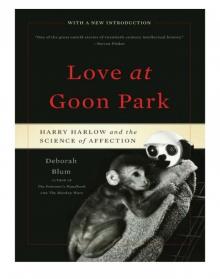 Love at Goon Park: Harry Harlow and the Science of Affection
Love at Goon Park: Harry Harlow and the Science of Affection The Poison Squad
The Poison Squad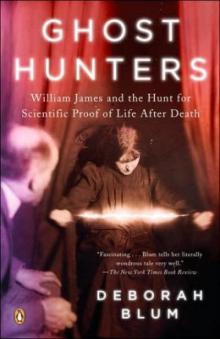 Ghost Hunters: The Victorians and the Hunt for Proof of Life After Death
Ghost Hunters: The Victorians and the Hunt for Proof of Life After Death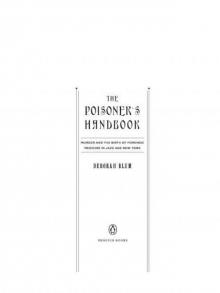 The Poisoner's Handbook
The Poisoner's Handbook Angel Killer
Angel Killer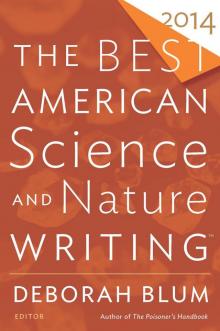 The Best American Science and Nature Writing 2014
The Best American Science and Nature Writing 2014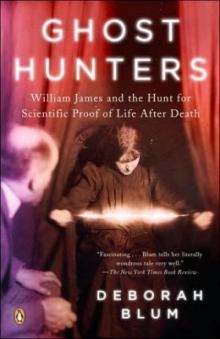 The Ghost Hunters
The Ghost Hunters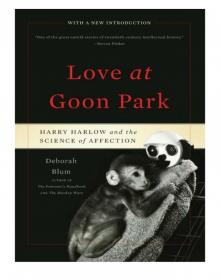 Love at Goon Park
Love at Goon Park